10 Best E‑commerce Platforms for Developers and Business Owners in 2025
Explore 10 leading e‑commerce platforms for 2025—including monolithic SaaS solutions like Shopify, BigCommerce, and Magento; composable headless options such as CommerceTools and Commerce Layer; and unified GraphQL/PIM‑powered platforms like Crystallize. Match your business model, technical requirements, and budget to find the optimal balance of ease‑of‑use, performance, and flexibility.
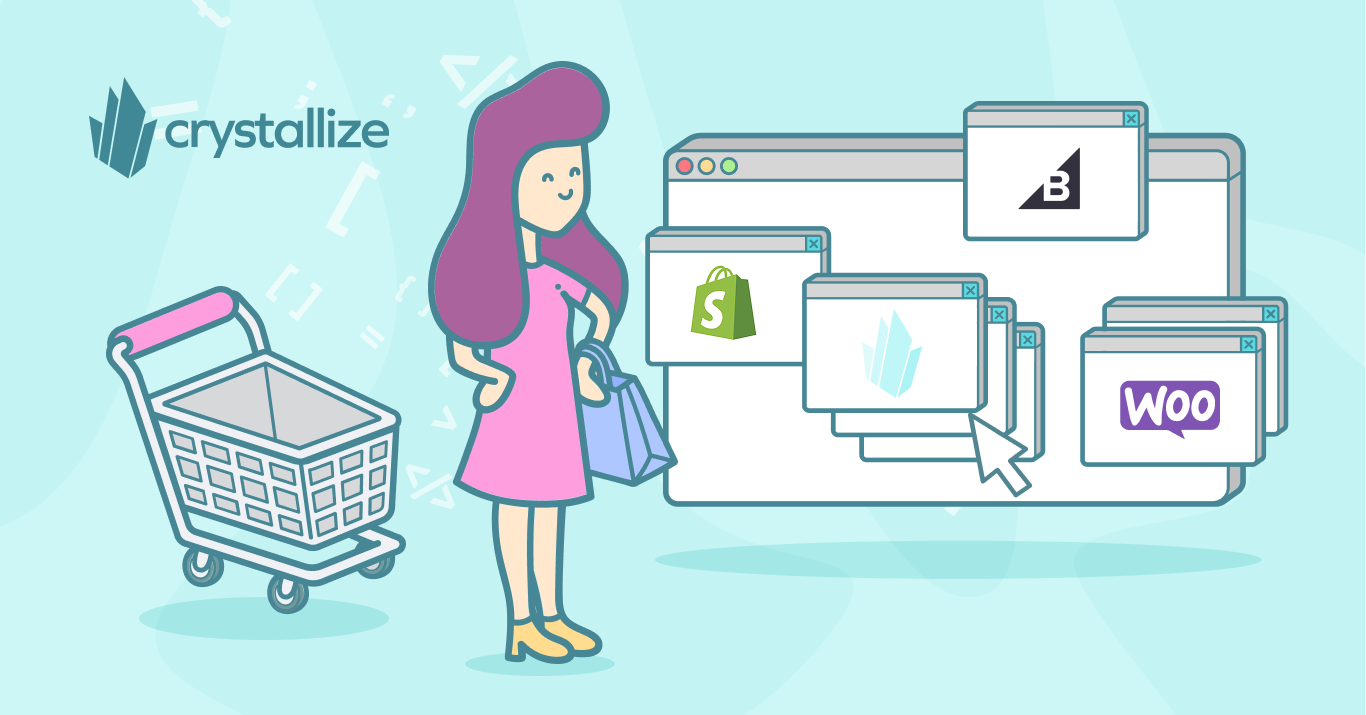
Gartner Magic Quadrant view, business expectations, industry leaders' opinions, and most popular solutions… best of articles come in all shapes and sizes. This one of ours about eCommerce platforms in 2025 is a bit different, we hope.
Open-Source, SaaS (software-as-a-service), monolith, or headless platform for your online store? Choosing the right e-commerce platform is a daunting task and can make or break your online business. In today’s fast-paced market, both ease of use and technical flexibility are key.
Imagine trying to build a house on a shaky foundation. It’s a disaster waiting to happen, right? Similarly, choosing the wrong e-commerce platform is like setting up your online store on a shaky foundation.
Whether you’re a developer seeking a customizable solution or a business decision-maker looking for quick setup and scalability, you need a platform that fits your needs - one that ensures your store runs smoothly, is secure, and provides an excellent shopping experience.
Before we dive into summarizing each platform’s overview, highlighting its key strengths, and suggesting ideal use cases, a quick TL; DR should help you skim the possible solutions.
By the end of the article, you’ll have a clear picture.
✅TL; DR.
Platform | Pricing (Starter → Enterprise) | Tech Stack | Hosting | API Type | Market Share | Ideal Use Case |
|---|---|---|---|---|---|---|
Shopify | Basic: $29 /mo → Advanced: $451 /mo; Plus: $2,300 /mo | Ruby on Rails | SaaS cloud on Shopify’s managed infrastructure | REST & GraphQL | 6.7 % | SMBs & omnichannel starters |
Magento (Adobe Commerce) | Open Source: free & self‑hosted; Adobe Commerce: $22 k → $125 k / yr | PHP (Zend, Symfony), Elasticsearch | Self‑hosted or Adobe’s Cloud SaaS | REST & GraphQL | 2.32 % | Medium–large firms needing deep customization |
BigCommerce | Standard: $39 /mo; Plus: $105 /mo; Pro: $499 /mo ; Enterprise: custom (≥ $1,000 /mo) | PHP, Node.js; Handlebars (Stencil); MySQL | SaaS cloud platform | REST & GraphQL | N/A | SMBs, mid‑market & B2B enterprises |
commercetools | Custom enterprise pricing (contact sales) | Cloud‑based microservices architecture | SaaS on global cloud infrastructure | REST & GraphQL | 0.1 % | Enterprises needing composable, API‑first solutions |
Commerce Layer | Free and Enterprise: custom | API‑first headless platform | SaaS headless cloud | REST APIs & Webhooks | Niche (< 0.01 %) | Startups → large brands needing flexible headless commerce |
Crystallize | Particle: free (+ metering); Atom: $499 /mo; Crystal: custom | GraphQL‑based PIM & headless API | SaaS cloud service | GraphQL only | N/A | Product‑led brands & agencies needing rich PIM + headless commerce |
Understanding your needs first, and once you do that, consider the following:
- Choosing the wrong e-commerce platform is like building on a shaky foundation. Many businesses are already using headless architectures to ensure performance and agility rather than being locked into monolithic systems.
- Shopify remains the most widely used e-commerce solution. Mid-to-large enterprises adopt Magento and come with significant developer resources to manage and maintain.
- Composable, API-first platforms like CommerceTools and Commerce Layer let developers assemble best-of-breed services.
- Crystallize unites super-fast GraphQL APIs with rich content management and PIM features—powering headless 3D/AR configurators, subscriptions, and global CDNs—to deliver both developer agility and business-friendly editing in one platform.
Understanding Your Needs
Understanding your needs comes first (actually, the product or service comes first, then this). That means Determining Your Business Model, Knowing Your Audience, and Analyzing Your Technical Requirements. Let’s break down the three a bit.
Okay, so first up, let's figure out what kind of online store you want to run, i.e., determining your e-commerce business model. Think about what you'll sell—stuff you can hold, things you download, memberships, or maybe a bit of everything. Then, who are you selling to? Other companies or everyday people? Different online shops are better suited for different things, so choose one that makes sense for how your business operates.
This means understanding your audience. It is like knowing the ingredients of a recipe—it’s essential. Are your customers tech-savvy? What devices do they use? What is their buying journey? Where do they hang out, and how do they gather information about products like yours? Answering these questions will help you find and choose a platform that provides the experience your audience expects.
Finally, technology is the linchpin that holds the wheel together. From the underlying website architecture to the frontend interfaces and preferred solutions, and your team's tech know-how, technology determines the efficiency, security, and user experience of your business, team, and online store.
A Look at the Best eCommerce Platforms in 2025
Nowadays, advising on the best [insert anything here] is a two-edged sword. That’s why we prefer to talk about some of the most popular solutions rather than rank them as the best. Also, although it helps that these are our competitors, it makes it hard to maintain unbiased opinions.
Anyway, let's introduce you to some solutions worth checking. Let's start with monoliths and traditional platforms.
Shopify
Shopify has a 6.7% market share of content management systems (CMS) and e-commerce, making it the most widely used e-commerce solution (source). Only WordPress has a bigger share. So, we can't really talk about e-commerce without mentioning Shopify, a widely recognized all-in-one platform known for its user-friendly interface and comprehensive feature set.
In essence, Shopify is a hosted SaaS solution that lets you create an online store without worrying about server management or extensive coding. Founded in 2006, it now powers millions of businesses worldwide, from small, local shops to large brands. Shopify Plus caters to enterprises and more tech-oriented brands.
Everything you need (website builder, shopping cart, payments, inventory, shipping, etc.) is bundled in, so you can launch a store in a matter of hours. For business owners, Shopify’s appeal is that you can start selling online quickly with minimal technical expertise while still having room to grow.
Key Strengths. Shopify’s intuitive and user-friendly interface makes it easy to set up and manage an online store. You don’t need to be a developer – many non-technical users launch fully functional stores using Shopify’s visual themes and settings. This low barrier to entry is a massive draw for small businesses.
Shopify provides hosting, security, software updates, and a suite of built-in tools, including product catalog management, SEO basics, and marketing features. Everything is tightly integrated, which means less hassle with configuration. Out of the box, you get a reliable storefront, a secure checkout, and even in-person point-of-sale options.
One of Shopify’s biggest strengths is its enormous marketplace of themes, plugins, and apps. Need a specific functionality (like a subscription service, loyalty program, or advanced analytics)? There’s likely an app for it. This ecosystem, combined with Shopify’s large user community and documentation, means help is readily available. Developers also appreciate that they can extend Shopify through apps or custom themes, using Liquid, Shopify’s templating language, when needed.

Ideal Use Cases. If you want to launch quickly with minimal fuss, Shopify is often the go-to. It’s perfect for businesses that don’t have a tech team and prefer a do-it-yourself solution. You can start small and lean, then upgrade plans or add apps as you grow.
Shopify excels when you need a platform that works out of the box. Retailers, boutiques, or anyone who wants to focus on products and marketing rather than infrastructure will find Shopify’s managed approach very convenient.
Shopify lets you sell through your website, social media, online marketplaces, and even brick-and-mortar (via its POS system) in a unified manner. It’s great for a business owner who wants to manage all sales channels in one place without custom integrations.
For all its strengths, Shopify does have some trade-offs. Its closed ecosystem means you are somewhat limited in how Shopify does things – deep customization of backend logic is not possible. You might need to adapt your business processes to fit Shopify’s framework.
While it offers many apps, relying on third-party apps can increase costs and sometimes lead to higher maintenance overhead. Customization beyond a certain point may require developer help or might not be feasible due to platform constraints (for instance, if you want a very unique checkout flow, you might hit a wall). Additionally, monthly fees and transaction fees (if not using Shopify’s payment system) can add up.
Shopify is fantastic for ease and speed, especially for smaller operations. However, larger or more complex businesses may eventually find that their flexibility is limiting and costs are increasing as they scale. At this point, a more custom solution could be considered.
How does Shopify compare to other e-commerce platforms? Visit our comparison pages, starting with Shopify vs. Crystallize😆 and Shopify vs. Magento and Shopify vs. Centra (more options at the compare tool main page).
Magento (Adobe Commerce)
Magento is a longstanding eCommerce platform known for its rich features and high degree of customization. First released in 2008 as an open-source solution, Magento has powered numerous online stores over the years, particularly mid-sized to large businesses that require more control than simpler platforms offer.
In 2018, Magento was acquired by Adobe and is now available in two main versions: Magento Open Source (free, self-hosted) and Adobe Commerce (the paid, enterprise version with additional features and cloud hosting). Despite the branding changes, many still refer to the platform simply as Magento.
Magento is a monolithic (all-in-one) platform that includes a built-in storefront, backend, and database in one package. Its APIs allow for headless use. Magento’s hallmark is extensibility—if you have the technical skills, you can customize almost every aspect of your store’s functionality and appearance.
Key Strengths. Magento comes packed with features that serious online retailers need. Right out of the box, it supports complex product types, multi-store management (running multiple stores from a single backend), multi-language and multi-currency support, robust promotion and discount rules, customer groups, and more. With proper server infrastructure, it’s designed to handle extensive catalogs and high order volumes. In terms of sheer capabilities, Magento is hard to beat—it’s a complete toolbox for e-commerce.
The open-source nature of Magento means you have full access to the code. Development teams can create custom modules or modify core behavior to tailor the platform precisely to business requirements. There’s a vast marketplace of third-party extensions and themes, allowing you to easily add pre-built functionality, from SEO enhancements to payment gateways. If a plugin doesn’t exist, a developer can build it. This level of control is a significant advantage for businesses with unique needs.
Magento has been around for a long time, so it boasts a large community of developers, agencies, and experts. There are plenty of forums, documentation, and experienced Magento specialists available. For businesses, this means it’s relatively easy to find support or hire talent for Magento development. Also, Magento’s ecosystem includes many off-the-shelf integrations with ERP systems, CRMs, and other enterprise software, reflecting its use by larger companies.
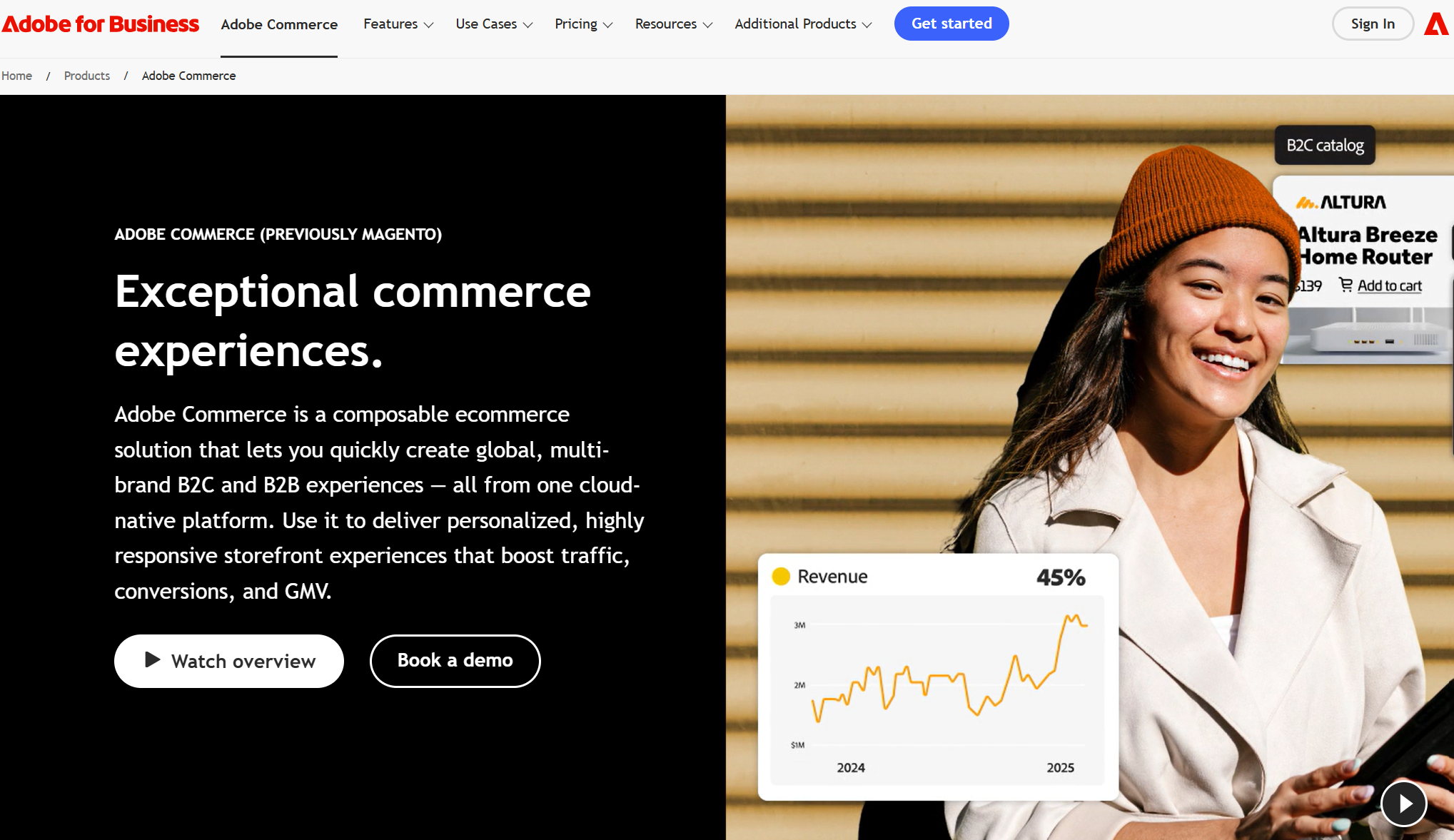
Ideal Use Cases. Magento Open Source is often ideal for medium— to large-sized businesses that need a highly customizable and scalable platform, especially those with the technical resources to support it. Suppose you have a complex catalog or business model (for example, a multi-vendor marketplace or a B2B store with custom pricing per client). In that case, Magento can likely handle it with the proper configuration or extensions.
If you prefer an on-premise or self-hosted solution where you own your data and code, Magento stands out (in contrast to SaaS platforms). Companies that want the freedom to host on their preferred servers or cloud and the ability to customize any aspect of the system will appreciate Magento’s open-source core.
Magento is powerful, but to use it effectively, you’ll need skilled developers (or a budget for an agency). It’s best to have the technical expertise to set it up correctly, optimize it, and maintain it.
It’s worth noting that Magento is not the easiest platform to use or maintain for the non-technical. Setup and hosting require knowledge—you have to install the software, manage servers, apply updates and patches, and so on. Magento can also be resource-intensive; it may require a robust server or Adobe’s cloud hosting to run smoothly, especially during periods of high traffic. This translates to higher hosting costs and maintenance effort compared to cloud platforms that manage this for you.
Additionally, while the core software (Open Source edition) is free, you will invest in development and possibly paid plugins, which can significantly increase the total cost of ownership.
In summary, Magento offers unmatched flexibility and power, but it’s best for those who truly need that level of control and have the means to support it. If your store is small or you lack tech support, a more streamlined solution might better serve you.
How does Magento compare to other e-commerce platforms? Visit our comparison pages, starting with Magento vs. Crystallize😆 and Magento vs. Litium and Magento vs. Commercetools (more options at the compare tool main page).
Big Commerce
BigCommerce is a leading SaaS e-commerce platform that serves primarily SMBs and mid-market enterprises. It offers a comprehensive feature set, including a rich app ecosystem, headless commerce support, and strong multi-channel capabilities. The platform powers over 80,000 merchants globally and has vertical strengths in B2B, omnichannel retail, and enterprise modernization.
BigCommerce excels at content-driven commerce. Though it started as a monolith, its open, API-first architecture supports composable commerce and headless front-end frameworks like React or Next.js. This enables developers to craft custom storefronts while retaining a managed backend. However, it faces stiff competition from Shopify and Magento.
Key Strengths. Native B2B tools (price lists, custom catalogs), enterprise-grade security, and PCI compliance reduce time to market for medium- to large merchants. They also have a flexible API-first architecture that allows decoupled front-ends on any framework while leveraging BigCommerce’s backend commerce services.
Finally, the extensive app store and integrations (payments, shipping, ERP) simplify extending functionality, and the certified agency ecosystem supports complex implementations.
Drawbacks? Or challenges? A smaller third-party developer community compared to Shopify means fewer free themes and plugins, and enterprise merchants may need custom development. This is not good when you add high transaction fees and tiered revenue thresholds, which can escalate costs rapidly for fast-growing merchants.
Ideal Use Cases. BigCommerce targets small and mid-market merchants (annual online sales <$50M), as well as scaling enterprise and B2B brands through specialized editions and partner programs.
What Else Is There?
Many companies use WooCommerce, which runs on WordPress. It's a really solid option, especially if you're used to the WP universe (it sounds like a superhero movie commercial!). PrestaShop is another good option, similar to the above, a proprietary all-in-one platform.
Then we have platforms like Centra and Litium. Litium is a great fit for mid-market to enterprise businesses looking for strong built-in CMS and campaign tools along with their commerce features. Centra, on the other hand, is perfect for big brands that need fast, global omnichannel setups with continuous, always-up-to-date updates and real-time fulfillment straight from their stores. Check Litium vs. Centra page or Shopify vs. Litium or Centra vs. Crystallize (more options at the compare tool main page).
You also have website builders like Wix, Squarespace, and Weebly that offer e-commerce, but they're not as full-featured. They could work okay if you're just starting and don't have a vast product catalog, though.
Our comprehensive guide to Modern e-commerce Web Development covers approaches, stacks, and platforms available today in more general terms.
Going the Headless Way
With Shopify Plus, we’ve opened the door (at least in this article) to new tools and solutions relying on headless architecture. The central premise and benefit of the headless approach is the decoupling of the frontend presentation and backend functionalities.
In practice, this means you have a single source of truth: the backend that stores all the data you need, including product and marketing data. This allows you to use any frontend you like in your headless tech stack, any way you want. This approach gave rise to modern headless commerce solutions, such as CommerceTools, Commerce Layer, and OFC Crystallize.

Commerce Tools
Commercetools really took off in 2010 as a frontrunner in headless commerce. It's all about APIs and using a microservices setup, and it fits right in with the whole MACH philosophy (that's Microservices, API-first, Cloud-native, Headless). They're mainly focused on mid-market to large enterprises needing a flexible, composable tech stack and offer a pretty adaptable tech setup, perfect for complex, growing businesses.
Commercetools acts as a backend commerce engine (product catalog, carts, orders, etc.) that developers can integrate with any front-end or channel via APIs built to handle large product catalogs and traffic spikes for big brands.
Key Strengths. The microservices-based, composable commerce design allows fine-grained customization. You can tailor or replace individual components of your e-commerce stack without overhauling everything. This makes it easy to scale specific services, such as inventory or checkout, independently as your business grows.
Because everything is accessible via APIs, frontend developers have total freedom to create custom user experiences on any device or framework. It’s language-agnostic on the frontend – you can use React, Angular, mobile apps, or even IoT devices as your “storefront” while Commercetools handles the backend logic.
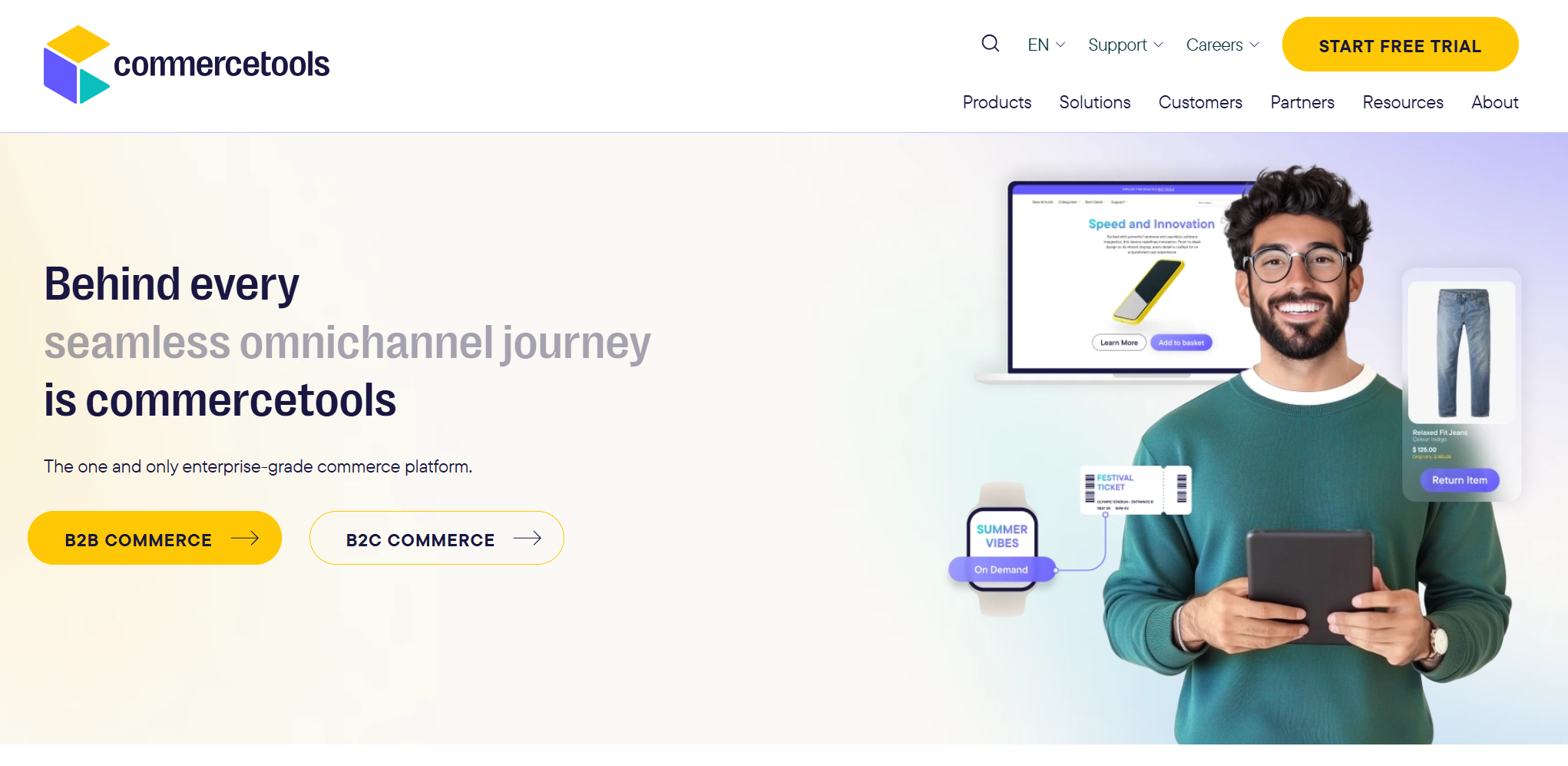
Ideal Use Cases. Enterprises or mid-sized companies with complex needs (e.g., international stores, multiple brands) benefit from the scalability and modular architecture. If you expect huge traffic or have thousands of SKUs, Commercetools’ cloud infrastructure can scale with you.
To unlock Commercetools’ potential, you’ll need developers to integrate services and build the frontend. It’s ideal when you have an in-house tech team or a capable agency ready to customize your e-commerce setup. In return, developers get a lot of flexibility and freedom to integrate best-of-breed services, rather than being locked into a single ecosystem.
There is a steep learning curve and reliance on third-party services to complete features (e.g., you might use a separate CMS, search service, etc.), which can add to costs and maintenance. Commercetools shines for ambitious projects that value flexibility over turnkey simplicity.
How does Commercetools compare to other e-commerce platforms? Visit our comparison pages, starting with Commercetools vs. Crystallize😆and Commercetools vs. Shopify or Centra vs Commercetools (more options at the compare tool main page).
Commerce Layer
Think of Commerce Layer as a lightweight but powerful set of commerce building blocks delivered via APIs, rather than a traditional all-in-one store builder. It’s often described as an enterprise commerce API for modern developers, designed to be composable, fast, and easy to implement. With Commerce Layer, you can add global shopping functionality (products, carts, checkouts, etc.) to websites, mobile apps, chatbots, IoT devices, or any frontend without being tied to a specific CMS or storefront technology. This makes it a flexible choice for companies that perhaps already have a content site or mobile app and want to add e-commerce to it seamlessly.
Key Strengths. The APIs expose all features (from managing products to processing orders) for developers to use in whatever front-end they choose. This gives technical teams a lot of freedom: You can integrate Commerce Layer with a static site generator, a native mobile app, or even another CMS. It’s a plug-in commerce for any experience.
It’s designed for brands that sell in multiple markets and need features like localized pricing, international shipping options, and global inventory tracking. In other words, it can scale with you as you expand internationally, ensuring that each market can be managed from a single platform.
Compared to big monolithic platforms, Commerce Layer is relatively lightweight. It focuses purely on commerce (no CMS or heavy frontend theming engine included), which is a strength if you want a clean separation. You can pick and choose best-of-breed solutions for content, search, and so on, and let Commerce Layer handle just the transactional parts (products, orders). This composable approach means faster performance and less bloat – you use only what you need.
Ideal Use Cases. If you already have a content-rich website or mobile app and now want to add shopping functionality, Commerce Layer is ideal. For example, a media site could integrate Commerce Layer to sell merchandise without migrating to a whole new platform.
Businesses that want a single backend for multiple storefronts or channels (e.g., a web store, mobile app store, social commerce, etc.) will benefit from Commerce Layer. Finally, Commerce Layer is a great choice when a development team wants control over the front-end experience and integration stack.
As a headless solution, it requires more integration effort upfront than a turnkey SaaS like Shopify. The flip side of its composability is that non-technical users might find it less immediately approachable, as there’s no visual store builder – it’s geared toward developers to set up.
Additionally, Commerce Layer is a newer player, so its community and plugin marketplace are smaller (most extensions or customizations will be done via code rather than installable apps). Pricing can also scale up depending on usage and enterprise features.
How does Commerce Layer compare to other e-commerce platforms? Visit our comparison pages, starting with Commerce Layer vs. Crystallize😆and Commercelayer vs. Saleor and Magento vs. Commercelayer (more options at the compare tool main page).
What About Crystallize?
Crystallize is built with developers and performance in mind. GraphQL API, cloud-native architecture, and integration with global CDNs ensure fast content delivery and can scale to accommodate fluctuating traffic. Imagine it as a high-speed train that automatically adds more carriages based on the number of passengers.
But the strongest point is that Crystallize combines product information with rich marketing content, and subscriptions, and orchestrates order intake and fulfillment like no other platform on the market. It allows you to serve your customers with all the information (product and marketing) and track their journey from placing an order to making a purchase and delivery.
Key Strengths. We urge you to take a tour with our promo pages or (why not?) schedule a personalized 1-on-1 demo. But quickly here:
- A standout feature is how we combine product information with rich marketing content and media in one place.
- Super-fast GraphQL APIs + global CDN to cache content
- Dev-focused to set up, but not to run. Once you set it up, Crystallize is easily managed for content editors, product teams, and shop admins (or whatever you label the roles).
Ideal Use Cases. With the level of personalization that comes with Crystallize, we pretty much check a lot of boxes. Enterprise companies looking for flexibility and ease of scaling are often surprised by the performance they deliver as well. With built-in support for subscription commerce and the flexibility to model complex products, services, and prices, Crystallize can serve multiple business models.
Crystallize may involve a learning curve for developers new to its paradigm, particularly getting used to GraphQL if they haven’t used it before. Reliance on dev is probably the biggest drawback (if you haven't got one on your play role. But if you do, using it is a developer's delight.
How does Crystallize compare to other PIM, commerce, and CMSs? Visit our tech comparison pages😆
What About Crystallize?
Crystallize is built with developers and performance in mind. GraphQL API, cloud-native architecture, and integration with global CDNs ensure fast content delivery and can scale to accommodate fluctuating traffic. Imagine it as a high-speed train that automatically adds more carriages based on the number of passengers. But the strongest point is that Crystallize combines product information with rich marketing content, and subscriptions, and orchestrates order intake and fulfillment like no other platform on the market. It allows you to serve your customers with all the information (product and marketing) and track their journey from placing an order to making a purchase and delivery. Key Strengths. We urge you to take a tour with our promo pages or (why not?) schedule a personalized 1-on-1 demo. But quickly here: A standout feature is how we combine product information with rich marketing content and media in one place. Super-fast GraphQL APIs + global CDN to cache content Dev-focused to set up, but not to run. Once you set it up, Crystallize is easily managed for content editors, product teams, and shop admins (or whatever you label the roles). Ideal Use Cases. With the level of personalization that comes with Crystallize, we pretty much check a lot of boxes. Enterprise companies looking for flexibility and ease of scaling are often surprised by the performance they deliver as well. With built-in support for subscription commerce and the flexibility to model complex products, services, and prices, Crystallize can serve multiple business models. Crystallize may involve a learning curve for developers new to its paradigm, particularly getting used to GraphQL if they haven’t used it before. Reliance on dev is probably the biggest drawback (if you haven't got one on your play role. But if you do, using it is a developer's delight. How does Crystallize compare to other PIM, commerce, and CMSs? Visit our tech comparison pages😆
What Else is there?
73% of all businesses are currently using headless website architecture (source: headless commerce stats), which means that the adoption of headless is rapidly increasing. Among the many platforms available (and the ones mentioned here), Commerce.js, Swell, and Saleor stand out.
You can check, for example, Crystallize vs. Saleor or Shopify vs. Saleor (more options at the compare tool main page).
🔍Compare Crystallize with other leading e-commerce platforms!
Crystallize bundles PIM, commerce, and CMS into one powerful platform so you can launch faster, sell smarter, and delight customers everywhere—no more juggling tools or missing out on revenue
However, we know every project and team’s needs are different, so we put together clear, side‑by‑side tech comparisons that breaks down features, usability, pricing, and support.
You’ll notice that links to our in‑depth comparison pages are sprinkled throughout the article after each platform overview, making it effortless to jump straight to the side‑by‑side breakdowns...and we added a couple more here.
Feel free to dive in at your own pace—our goal is simply to arm you with the facts; you get to pick what works best!
How does Crystallize stack up against other platforms? (main page)

The Way People Shop Has Changin…
… and traditional commerce platforms (the monolith solutions) can't keep pace with the growing demands of modern customers. We might be biased, but headless commerce allows businesses to break free from the constraints of legacy systems, enabling them to deliver a seamless and personalized experience across all channels.
As we have seen all too often, using the wrong tool or one that is not designed for the use case is a recipe for disaster. Just as important as the tech is the team. The solution chosen needs to match the team that will customize and build the eCommerce experience, as well as the team that will run it.
Choosing an e-commerce platform is a topic for another article. Today, we hope we’ve sparked your interest in what's available.
We can help with that. Seriously, we can!
START building for FREE with Crystallize, or schedule a 1-on-1 demo so we can show you how Crystallize fits (or NOT) your use case.
Frequently Asked Questions
What is the cheapest platform to start with?
The cheapest platforms to start with are those offering free tiers or minimal entry costs—Commerce Layer provides a free forever developer plan, Crystallize offers a free Particle tier, and open‑source solutions like WooCommerce incur no software fees but require hosting.
Which platform offers the best headless API performance?
For headless API performance, GraphQL-first platforms (e.g., Crystallize, Shopify’s GraphQL Storefront API, commercetools) lead due to reduced overfetching and smaller payload sizes—GraphQL can reduce JSON payloads by up to 99% compared to REST.
Can I migrate from Magento to Crystallize?
Yes—Crystallize provides an open‑source Magento Migration Script that automates importing your Magento product catalogue, folder structures, and associations into Crystallize via its GraphQL API.
You Should Also Read👇
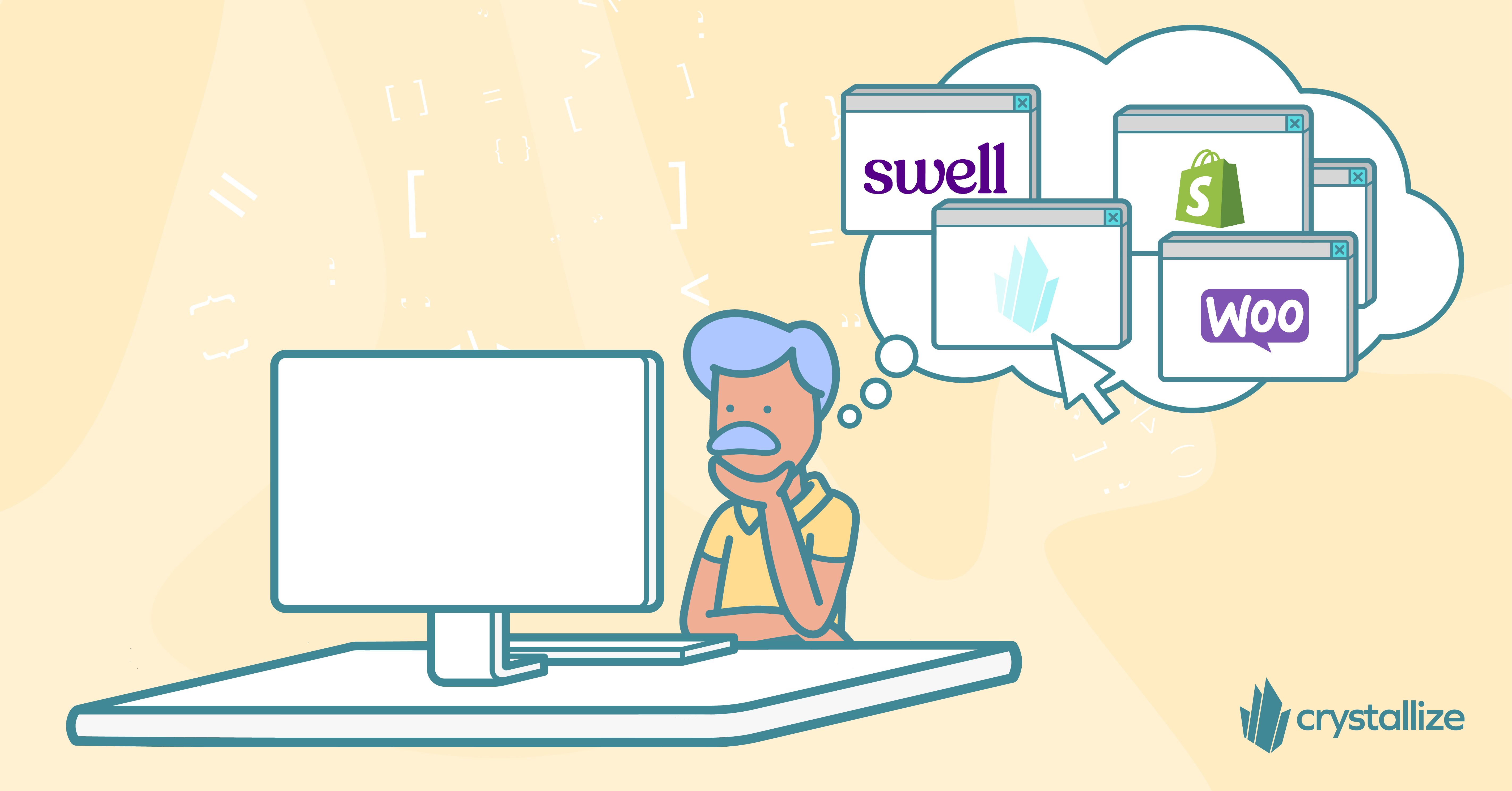
Choosing an eCommerce Platform Today Is Hard
Choosing the best eCommerce platform is one of the most important decisions you must make at the very start of your eCommerce journey if you want to have a jaw-dropping, money-making storefront.

The Ultimate Guide to eCommerce Business Models (B2B, B2C, DTC & More)
Explore the different eCommerce business models—B2B, B2C, DTC, B2G, and more. Learn how to choose the right model for your online business and scale with modern strategies.
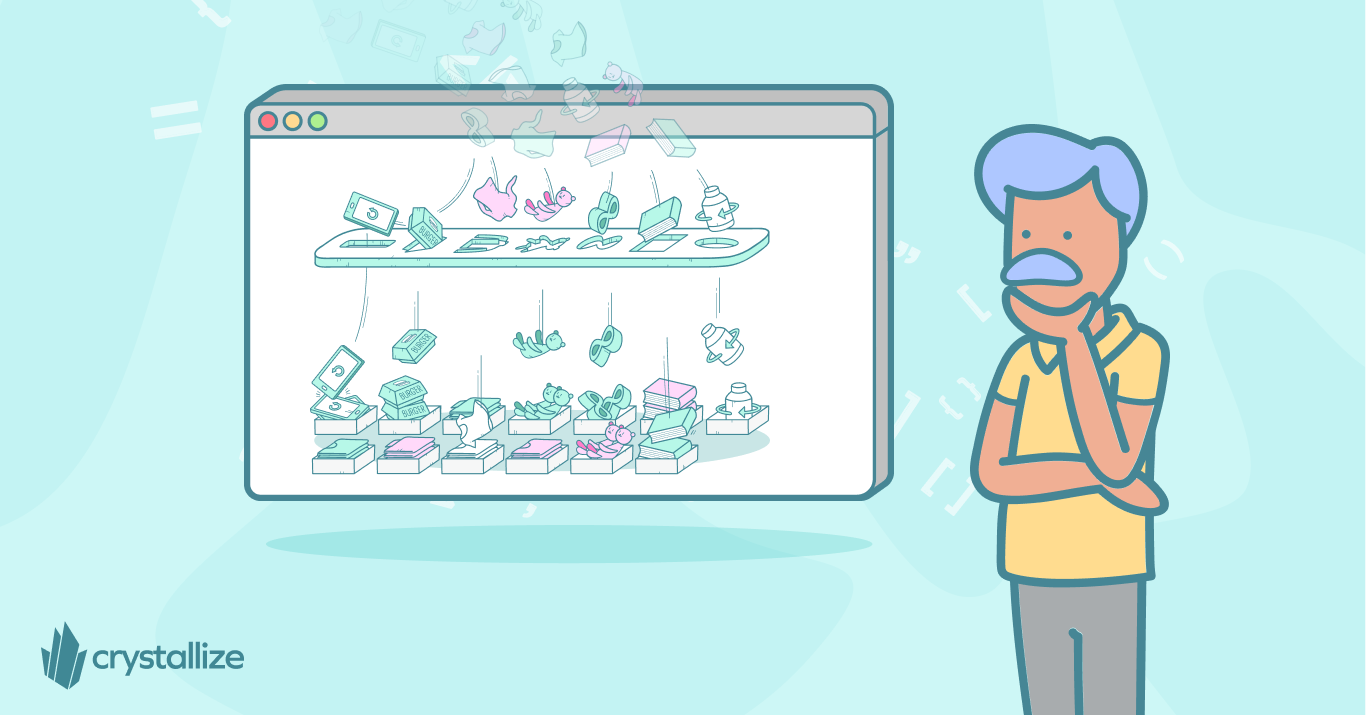
Best PIM Platforms in 2025: Compare the Top 8 Solutions Side-by-Side
Discover the top 8 leading Product Information Management (PIM) platforms in 2025, their features, benefits, and how to choose the right solution for your business needs.

